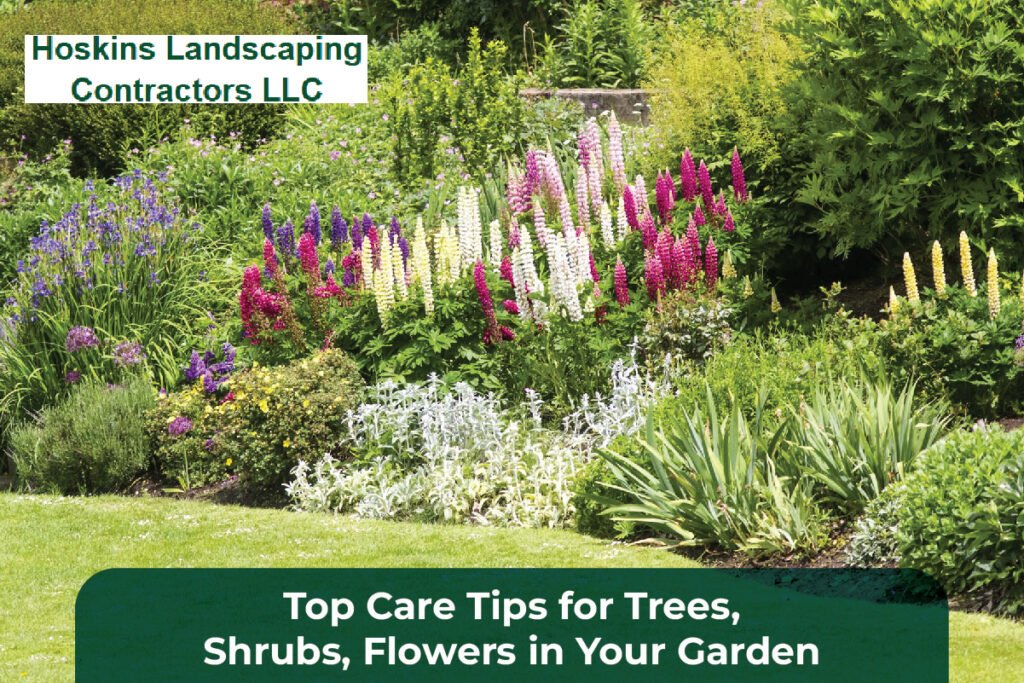A thriving garden filled with vibrant trees, shrubs, flowers isn’t just a visual delight—it’s a personal retreat, a wildlife haven, and a mark of sustainable living. Whether you’re a beginner or a seasoned green thumb, understanding the right care tips for these garden staples is crucial to ensure they flourish year-round.
In this comprehensive guide, Hoskins Landscaping & Contractors LLC will explore top care techniques that will help your trees, shrubs, flowers stay healthy, resilient, and beautiful through the seasons.
1. Understand Your Local Climate and Soil Type
It’s critical to comprehend the surroundings of your garden before planting anything. Different trees, shrubs, flowers thrive in different conditions:
- Climate: Is your area hot and dry or cool and wet? Native plants generally perform best as they’re adapted to the local climate.
- Soil Type: Conduct a soil test to determine pH levels and nutrient content. This helps in selecting the right fertilizer and amendments.
Tip: Most flowering plants prefer slightly acidic to neutral pH, while many shrubs and trees are more flexible.
2. Proper Plant Selection and Placement
Choosing the right species for your garden’s microclimate ensures longevity and fewer maintenance headaches.
- Trees: Opt for varieties suited to your region’s average rainfall and sun exposure.
- Shrubs: Consider evergreen versus deciduous depending on whether you want year-round foliage.
- Flowers: Go for a mix of perennials and annuals to ensure year-round color.
Ensure you space out trees, shrubs, flowers properly to avoid overcrowding, which can lead to disease and poor growth.
3. Watering Techniques That Work
One of the most common mistakes is either under-watering or overwatering.
General Rules:
- Trees: Weekly deep watering is usually preferable to weekly shallow watering. This encourages deep root growth.
- Water the base of shrubs to prevent fungal diseases. Morning watering is best.
- Flowers: Annuals may need more frequent watering, especially during dry spells. Use mulch to retain moisture.
Bonus Tip: Consider installing a drip irrigation system to provide consistent moisture without water waste.
4. Mulching: A Must-Do Practice
Mulch is magic for trees, shrubs, and flowers. It not only retains soil moisture but also regulates temperature and suppresses weeds.
Best Practices:
- Make use of compost, bark, or straw as organic mulch.
- To avoid rot, keep mulch a few inches from the bases of shrubs or tree trunks.
- Reapply mulch yearly or as needed.
Mulching also adds organic matter back to the soil as it breaks down—feeding your garden naturally.
5. Regular Pruning and Deadheading
Pruning is essential for healthy growth and aesthetic appeal.
- Trees: Before new growth begins, prune them in late winter or early spring. Remove dead, diseased, or crossing branches.
- Depending on the kind, prune shrubs either immediately after flowering or in late winter.
- Flowers: Deadhead spent blooms to encourage more blossoms and prevent seeding.
Tools should always be sharp and sanitized to avoid spreading disease.
6. Fertilizing for Optimum Growth
Feeding your trees, shrubs, and flowers provides them the nutrients they need to thrive.
How to Fertilize:
- Use a balanced slow-release fertilizer in spring.
- Flowering plants may benefit from higher phosphorus content.
- An excellent organic choice for trees and shrubs is compost.
Always follow package instructions to avoid over-fertilization, which can burn roots and inhibit blooming.
7. Seasonal Maintenance is Key
Each season brings its own set of tasks:
- Spring: Start fertilizing, mulching, and planting new additions.
- Summer: Focus on watering, weeding, and deadheading.
- Fall: Time to prune, plant trees or shrubs, and prepare for dormancy.
- Winter: Protect sensitive plants with covers or bring potted plants indoors.
Keep a garden journal to track when you planted, fertilized, or pruned.
8. Watch for Pests and Diseases
Early detection can save your plants.
Common Problems:
- Aphids, mites, and caterpillars on flowers and shrubs.
- Fungal issues like powdery mildew or rust.
- Borers or bark beetles on trees.
Use integrated pest management (IPM): identify pests, encourage natural predators, and use targeted treatments as a last resort.
9. Attract Pollinators and Beneficial Insects
A healthy garden is a buzzing garden.
- Include flowering plants like lavender, echinacea, and bee balm.
- Avoid pesticides that harm bees and butterflies.
- Add bird baths or bee hotels for added biodiversity.
Healthy trees, shrubs, flowers support the local ecosystem and promote better blooming through pollination.
10. Don’t Neglect the Aesthetics
While function is key, form adds joy.
- Mix heights and textures for visual interest.
- Create focal points with flowering shrubs or small ornamental trees.
- Layer plants: tall trees at the back, medium shrubs in the middle, and colorful flowers in front.
Your garden should reflect your personality—whether it’s wild and whimsical or clean and structured.
Final Thoughts
Caring for your trees, shrubs, and flowers doesn’t have to be overwhelming. With a bit of planning, seasonal maintenance, and an eye for beauty, you can create a thriving oasis that brings joy and sustainability to your outdoor space.
Remember, every garden is a work in progress. Let it evolve, experiment with new species, and most of all—enjoy the process.
FAQs
Q1: How frequently should flowers, shrubs, and trees be watered?
A: Trees usually need deep watering once a week, shrubs 1–2 times weekly depending on weather, and flowers more frequently, especially in hot months.
Q2: Can I use the same fertilizer for all garden plants?
A: Not necessarily. Trees and shrubs often benefit from balanced fertilizers, while flowering plants may need higher phosphorus levels for blooming.
Q3: What’s the best mulch for all plant types?
A: Organic mulch like bark or straw is ideal. It enriches the soil while helping to retain moisture and control weeds.
Q4: When is the best time to prune?
A: Late winter or early spring is usually best, though flowering shrubs may require post-bloom pruning.
Q5: How can I make my garden more pollinator-friendly?
A: Plant native flowers, avoid pesticides, and add water sources or pollinator shelters.
